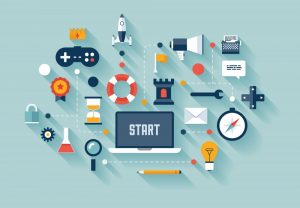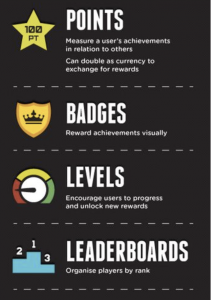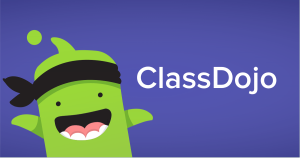What is Gamification?

According to the ISTE standards website, “Gamification is about transforming the classroom environment and regular activities into a game as it requires collaboration, creativity and play.” There are numerous ways to bring games and game playing into the classroom to promote learning and deepen student understanding of subject matter. Whether teachers are looking to bring some aspect of gaming into their class or use a game platform across the curriculum, they can use gamification elements to enhance learning and student engagement. In my ECI 201 class, we learned from a guest speaker that gamification is learning activities that incorporate point systems, badges, levels and leaderboards to encourage students to complete tasks and enhance their learning. This is different from game -based learning as gamification requires students to solve problems using game-based elements. On the other hand, game-based learning is when educators use games with specific educational purposes in the classroom. One of the major differences between gamification and game-based learning is that gamification allows for a complex process of designing and fitting various game elements into the classroom setting. Gamification is a great tool for educators as it take the premise of educational games and can be tailored to fit individualized classroom needs.
Gamify Systems
There are various systems educators can use to gamify activities or their classroom. Here are some of these systems:
Points- Points on a learning management system reward the learner who completes the most learning objects, as students gain points for certain tasks they complete. Moreover, points can be used to measure student achievement in comparison to other pupils. In some classrooms, points or experience points can double as currency to exchange for rewards. Before using the point system here are a few things educators should consider:

- Be sure to define your rules and stick to them: Without consistency, experience points are meaningless. Create your rule-sheet at an early stage and ensure everyone sticks to the rules.
- Also be sure to define your scale: How many points would a “good” action receive, and what does ‘awesome’ look like? Consider deciding the maximum available points for a single action first and let hierarchy of points reflect this. For example, if you pick 100 as your maximum number of points, you might create points-bands for 50, 25 and 10 points.
- Divide your content: Will you award more points depending on the type of learning objective? Will certain tasks be more points than others?
- Start small: Consider starting out with smaller point rewards to monitor student progress throughout the year. As they complete more difficult and complex tasks consider awarding student more points.
Badges– Badges reward student’s achievements visually. In other words, badges allow recognition of student’s hard work and various achievements.They also allow students to challenge themselves. If students aspire to earn badges, they must show mastery of various topics in multiple academic areas. In order to earn all badges, the student must challenge themself by learning a new set of skills or new information. Badges work as a form of motivation for students, while providing proof of mastery of a topic or skill for teachers to monitor student progress.
Leaderboards– Leaderboards organize students by rank. There are various ways to use this tool in the classroom, but on all leaderboards learners are ranked according to how many rewards they have achieved or collected. The good news is, leaderboards are not all about competition with other students and scrambling for top spot. Leaderboards can be used to encourage social learning, collaboration and knowledge sharing within the classroom. Therefore, leaderboards make games fun as they tap into the competitive spirit of students and act as a powerful engagement tool, driving children to keep pushing themselves.
Leveling Up– Leveling up encourages students to progress and unlock new rewards. Knowing the next level of status or challenge is just around the corner is a strong motivational tool for everyone, including young learners! Teachers can design each level to individually fit each student in their class, or groups of students. Levels are a perfect tool to incorporate in the classroom, as they are a part of everyday life; levels are about progressing to the next stage of possibility and learning.
Each of these elements offer educators the opportunity to turn simple or interesting tasks into games which encourage student mastery. These systems also allow teachers to define classroom goals and objectives they expect students to master throughout the year, as well as monitor student progress in reaching these goals. By using gamification in the classroom students can further engage and master the material all while earning points, receiving badges, climbing the leaderboard, or leveling up. To learn more about each system of gamification be sure to check out this website!
The Neuroscience of Gamification Learning: Why Gamification?
In the article, “The Neuroscience of Gamification“, researchers looked into the neurological science of gamification and the positive impact this type of learning has on students. Here are some important points the researchers found:
- Gamification forges an emotional connection: Gamification involves creating a narrative around the learning activity that describes why the task is relevant to the learner. Researchers found that participants’ attention is affected by emotion and priority, such that they pay more attention to particularly vivid information or details that are highly relevant to them, but their retention of low-priority information is impaired.
- Dopamine creates positive associations with learning: Dopamine or the feel-good hormone, is released whenever humans are rewarded for a specific action. Gamification focuses on giving learners instantaneous feedback which might not otherwise be available. By giving virtual rewards for achieving learning goals, learners begin to associate the learning with positive emotions, prompting them to seek more educational opportunities.
- The hippocampus controls recall: The hippocampus is an area in the lower section of the brain which is largely responsible for knowledge recall. During learning, a strong hippocampal activation makes the content easier to remember and in clinical tests, game play has been shown to stimulate these conditions.
- Badges and rewards can trigger serotonin release: Serotonin is a hormone that governs our overall mood; release of this hormone is triggered by remembering past success. The badge cabinet of a gamified learning management system lets learners get a serotonin rush whenever students look at rewards they have earned.
- Gamification helps deal with cognitive overload: One way that gamification can deal with cognitive load is to present the learning in a more game-like, challenge-based format. Along with the other neurological benefits of gamification, this approach helps to chunk the learning into smaller pieces that are easier to retain.
Overall gamification has many positive neurological effects on the minds of young learners. More teachers should consider brining different elements of gamification into the classroom as science shows there are many benefits to games in the classroom. To see more of the researchers findings in this study be sure to check out the article: The Neuroscience of Gamification
Gamification in the Classroom
There are many ways that teachers can use gamification in their classrooms. Professor Liz Kolb, Teacher Education at the University of Michigan uses various softwares to educate her students on gamification. In order to make quests, she uses various computer based softwares including Gradecraft which is a learning management system that helps instructors build gamified courses & encourages students to focus on the craft of learning. The software allows teachers to create quests for their students who can level up, and choose what tasks to complete for points. Another system she uses to create quests is Classcraft which also allows teachers to turn their curricula into personalized quests for their students while turning learning into an adventure. In order to use badges in her classroom, Professor Kolb integrates badges into the gaming software with online resources like Edmodo, Classbadges, and Credly awarding students as skills are mastered, while also keeping them engaged.
Here are some other resources educators have used to gamify class material:
Wakelet: allows educators to create scavenger hunts and quests for their students.
Google Sheets: can be a fantastic tool for adding elements like points, badges and leveling up. Check out Alice Keeler’s post and template.
Breakout EDU: Teachers can create quests to have their students “breakout” of locked boxes. The students can choose the order they complete breakout tasks, and earn badges for unlocking each breakout box.
Quizlet: A free tool that allows users to create flashcards, and review for tests. Users can master quiz decks and receive points as well as badges for knowing the flashcard decks. It is a great tool to use for study purposes and can be used at all grade levels.
To learn more about gamification tools be sure to check out this website: 20 Ways to Gamify your class
Personal Experiences with Gamification
Before ECI 201, I had no idea what the term Gamification meant, however I experienced multiple gamify systems in various classroom settings throughout my education. In ECI 201, I learned that teachers may borrow several elements from gamification to enhance the learning environment in their classrooms. I have had personal experience with gamification at the high school and elementary school levels. In high school, my teachers borrowed the point element as well as the leader board during review activities such as Kahoot. To review lessons or for exams, my teachers used Kahoot, an online quiz generator to assess our knowledge. During Kahoot quizzes, the questions would be displayed on the board and after receiving the quiz code each student would use their own technology to answer each question. Each question was worth a certain number of points and the points were kept track of on a class leader board. To give students further incentive, those who placed on top of a leader board earned extra credit on the exam or candy.

At the elementary school level, I have seen teachers use tools such as Class Dojo as well as clip charts. In the first grade classroom which I student taught, the teacher would have the student’s desks arranged into tables which would be used for Class Dojo teams. If the whole entire table did something good or finished a certain type of task they would get class dojo points and be able to level up their table as well as their team characters on Class Dojo. Another example of gamification my first grade class used was a clip chart. This was to measure individual student growth as students were allowed to move their clip up (level up) on the chart if they helped out a friend, completed work, or performed any other good behavior. If the student reached the top of the clip chart by the end of the day and stayed there, they would receive a star on their clip. If the student received five stars, they could upgrade their clip (level up) by decorating their clip or getting a new colored clip. Therefore, teachers may borrow leaderboards, points, badges band levels to enhance their classroom through gamification.
Conclusions
From my previous experiences with gamified systems as well as learning about the topic in ECI 201, I definitely would love to use some elements of gamification in my classroom. As I future elementary educator I can see the immense benefits of gamification in regards to student learning. Gamification as well as game based learning allows every student to participate with instantaneous feedback of work. With gamification students are allowed to fail and try again as learning happens by performing various activities at each students’ own pace. The challenge of gamification is constant which is perfect to push students to master various tasks as well as monitor their progress.

Specifically in my future classroom I would love to use a Clip Chart as it is a simple gamification system that would push students to try their hardest. I would be able to monitor student behavior and progress as well as reward students for excellent work. Another gamification element I would love to use is Class Dojo as my students would be able to collaborate with one another to earn points, badges and level up as a group. Overall I think that gamification is an excellent way to engage students and I cannot wait to use several aspects in my future classroom.